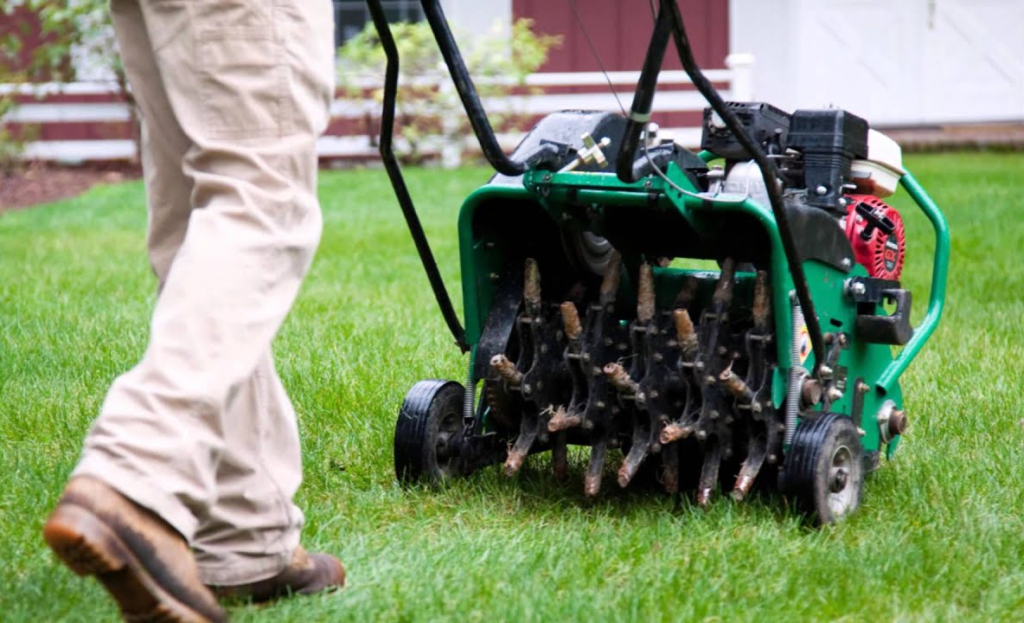Introduction
Lawn aeration is a fundamental practice for maintaining healthy grass. It involves perforating the soil with small holes to allow air, water, and nutrients to penetrate the root zone. This process alleviates soil compaction, which can hinder root development and overall lawn health. Understanding how often to aerate ensures that your grass thrives throughout the year.
What Determines Aeration Frequency?
Several factors influence how often a lawn needs aeration. These include soil type, foot traffic, grass species, and local climate conditions.
Soil Type
- Clay Soil: Dense and prone to compaction, requiring aeration at least once or twice per year.
- Sandy Soil: Drains quickly and doesn’t compact easily, needing aeration every two to three years.
- Loamy Soil: A balanced mixture of clay, sand, and silt that benefits from aeration once a year.
Lawn Usage and Traffic
- High Foot Traffic: Lawns that experience frequent activity, such as kids playing or pets running, compact faster and may require bi-annual aeration.
- Low Foot Traffic: If a lawn receives minimal use, annual aeration may suffice.
Grass Type
- Cool-Season Grasses (Fescue, Kentucky Bluegrass, Ryegrass): Best aerated in early fall.
- Warm-Season Grasses (Bermuda, Zoysia, St. Augustine): Benefit from aeration in late spring or early summer.
Climate Considerations
- Areas with heavy rainfall and high temperatures may lead to compacted soil faster, requiring aeration at least once a year.
- Drier regions with less compaction may only need aeration every two years.
Best Times to Aerate Your Lawn
The best time for aeration depends on the type of grass you have and your local climate.
Spring Aeration
- Ideal for warm-season grasses.
- Helps roots access moisture and nutrients before peak growing season.
Fall Aeration
- Best for cool-season grasses.
- Prepares the lawn for winter dormancy and promotes strong root growth.
Summer Aeration
- Typically not recommended unless absolutely necessary due to extreme soil compaction.
- Can stress grass if done in high heat.
How to Aerate Your Lawn Properly
Choosing the Right Equipment
- Core Aerators: Remove small plugs of soil for deeper aeration and better long-term results.
- Spike Aerators: Push holes into the soil but can sometimes worsen compaction over time.
Preparation Before Aeration
- Water the lawn one day before aeration to soften the soil.
- Mow the grass slightly shorter than usual.
- Mark sprinkler heads and underground utilities to prevent damage.
Post-Aeration Care
- Leave soil plugs on the lawn to decompose naturally and enrich the soil.
- Apply fertilizer and overseed if necessary to encourage thicker growth.
- Maintain regular watering to support recovery.
Maintaining a Healthy Lawn After Aeration
Regular aeration is just one part of lawn care. Combining it with other maintenance practices will maximize its benefits.
Fertilization
Aeration enhances nutrient absorption. Apply fertilizer right after aerating to boost root development.
Overseeding
Seeding after aeration improves lawn density and helps fill in bare spots.
Watering Schedule
- Keep the soil moist after aeration.
- Deep watering is recommended rather than frequent shallow watering.
Mowing Tips
- Avoid mowing for at least a week after aeration.
- Set mower blades to the correct height for your grass type.
Why Consistent Aeration Matters
Lawn aeration prevents common problems associated with compacted soil. Grass with well-aerated roots:
- Absorbs water and nutrients more efficiently.
- Grows thicker and healthier.
- Resists disease, weeds, and pests more effectively.
If your lawn is showing signs of compaction, such as water pooling, thinning grass, or slow growth, aeration can make a significant difference. Scheduling regular aeration ensures long-term health and a lush, green lawn.
Need Help with Lawn Aeration?
For professional lawn care services, All Seasons Landscaping & Lawn Care offers expert aeration tailored to your lawn’s needs. Our team provides aeration, overseeding, and fertilization services to help your grass stay strong year-round.
Conclusion
Regular lawn aeration supports healthy, resilient grass by improving soil structure and nutrient absorption. Identifying the best time and frequency for aeration ensures long-term success. If you’re unsure about when or how to aerate, professional services can simplify the process and keep your lawn in peak condition.
📞 Call us at (225) 276-8658
📧 Email us at [email protected]
Frequently Asked Questions
How do I know if my lawn needs aeration?
If water pools on the surface, the ground feels hard, or grass growth is slow despite proper care, aeration may be necessary.
Can I aerate my lawn myself?
Yes, but using a core aerator is recommended for the best results. Renting one or hiring professionals ensures thorough aeration.
Is it possible to aerate too much?
Over-aeration can stress the grass and soil. Most lawns only need aeration once or twice per year.
Should I fertilize after aeration?
Yes, fertilization after aeration enhances nutrient absorption and promotes healthy growth.
What happens if I don’t aerate my lawn?
Without aeration, soil compaction can lead to weak grass, poor drainage, and increased susceptibility to disease and pests.
What’s the difference between spike and core aeration?
Core aeration removes soil plugs, reducing compaction more effectively. Spike aeration creates holes but may compact surrounding soil over time.
Do all lawns need aeration?
Lawns with compacted soil, high foot traffic, or poor drainage benefit the most. Sandy or naturally loose soil may not require frequent aeration.
How soon will I see results after aeration?
Grass may start looking healthier within a few weeks, especially if combined with fertilization and overseeding.
Can I aerate in the summer?
Summer aeration is not ideal unless absolutely necessary, as heat stress can damage grass.
Does aeration help with thatch buildup?
Yes, aeration reduces thatch accumulation by improving microbial activity in the soil.
